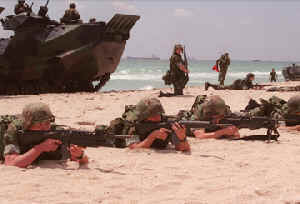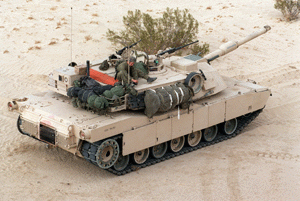The US Marine Corps is organized into three active-duty combat divisions because that is the minimum prescribed by the 1947 National Security Act; as amended by Title 10 in 1952. However, each of these divisions along with their supporting air wing and logistical support group have grown into a massive 38,000 man Marine Expeditionary Force (MEF). These three MEFs are too large to rapidly deploy, so the Corps plans to deploy them in 16,000 man components called Marine Expeditionary Brigades (MEB)s. It has three permanent MEB headquarters which are assigned components during a crisis. Obviously, reorganizing during a crisis and then heading off to war is unwise. Many proposals have been made to organize permanently into MEBs, but senior Generals are afraid to ask Congress to modify the 1947 act.
In 1942, the 1st Marine Division landed at Guadalcanal with 11,000 Marines, and that included service support elements. However, today's divisions have grown to over 15,000 Marines, which does not include several thousand support Marines who are kept "off the books" in its service support group. The simple solution is to organize into smaller 10,000 man divisions, basically larger MEBs with two infantry and one smaller artillery regiment each. Smaller divisions will allow each division to rapidly deploy and focus on either amphibious operations or expeditionary operations from Maritime Pre-positioned Ships (MPS). The Corps' three pre-positioned MEB equipped MPS squadrons will reorganize into two larger Maritime Pre-positioned squadrons to support two divisions.
| I MEF | Location | Mission | Regiments |
| 1st Marine Division | Pendleton CA | Amphibious | 1st, 5th, 11th |
| 3rd Marine Division | Hawaii/Okinawa | Expeditionary-MPS | 3rd, 4th, 12th |
| 5th Marine Division | Western USA | Reserves | 9th, 23rd, 13th |
| II MEF | Location | Mission | Regiments |
| 2nd Marine Division | Lejeune NC | Amphibious | 2nd, 6th, 10th |
| 4th Marine Division | Lejeune NC | Expeditionary-MPS | 7th, 8th, 15th |
| 6th Marine Division | Eastern USA | Reserves | 24th, 25th, 14th |
III MEF in Japan would be disestablished. The Corps has never needed three MEF-sized headquarters, and III MEF has always been understaffed. Some may prefer to redesignate MEFs as Marine Expeditionary Corps (MECs), or use the terms of PACMEC and LANTMEC.
The 1st and 2nd Marine divisions will focus on the amphibious mission. They will provide the forces for the current 2000-man forward-deployed MEUs, and share the requirement to maintain a MEU trained battalion task force on Okinawa, Japan for the 31st MEU. During a major war, these divisions will embark on all available amphibious ships, which is now referred to as an amphibious MEB. Ideally, these division headquarters will remain embarked on a Navy amphibious command ship on each coast for rapid deployment and to maintain Navy teamwork.
The 3rd and 4th Marine divisions will organize into two Maritime Pre-positioned Divisions (MPD). This will
clear up the MPS, MPF, MEB confusion. Each MPD will keep rotate personnel to keep a forward headquarters and maintenance element aboard the
ships and ready for instant deployment. In addition, each MPD will rotate
six-month forward deployments among their six infantry battalions to keep one
ready for immediate intervention. These will be similar to the current "air-contingency battalions".
The 5th and 6th division headquarters will be "stood up" by redesignating the 1st MEB and 2nd MEB headquarters. 3rd MEB headquarters will be disestablished. The question arises if the new 6th division should become a reserve division, or the 4th should remain one for simplicity. For this example, the 4th becomes active and the 6th a reserve. The 4th division headquarters moves to Lejeune from their old, isolated facility in New Orleans. Since that facility is a joint "Navy" facility, the Corps needn't worry about Congressional problems with "base closure", it can just leave. Marine Headquarters Reserve can move to Quantico or Washington DC.
Having a reserve division headquarters at the Corps' major base on each coast will save training money and improve the reserve force. The current arrangement of having the 4th division headquarters at New Orleans attempting to control reserve training and mobilization on each coast is difficult and impractical. Each division can absorb the Reserve Support Unit at Lejeune and Pendleton to save manpower. Ideally, the two reserve divisions will maintain minimal major equipment and maintain a sharing relationship with the MPD on each coast. The MPDs will be tasked with providing equipment and support for reserve units during their annual two-week training period. Even before MPD units fly off to link up with pre-positioned equipment overseas, reserve units will have arrived to take possession of the "stay behind" equipment. This will save the reserve force a great deal of money and allow them to quickly assemble on each coast with a full complement of gear left by the MPDs.
Since this plan balances Marine forces on each coast, the 7th Infantry regiment will move to Lejeune. The 9th Infantry regiment will be resurrected in the reserve force. This is possible if the Corps converts several reserve units to infantry units. For example, the reserves have two tank battalions and five artillery battalions, plus varied "special" units. Reserve infantry units are less expensive and easier to man since all Marines can fill basic infantrymen billets. Therefore, another infantry regiment in the reserves will save money and provide the infantry manpower needed if nasty urban fighting depletes the active force.
Two new artillery regimental headquarters will be "stood up"; the 13th and 15th. This will not require more manpower if the Corps embeds each artillery regimental headquarters into the Division G-3. Overall, this plan will shed over a thousand support positions with the deactivation of headquarters for III MEF and the 3rd MEB, and pulling Marines out of New Orleans. Artillery regiments with three battalions each will be tailored to support their light amphibious or heavier expeditionary divisions. For example, amphibious divisions need lighter and more mobile support, like 120mm mortar battalions rather than 155mm towed howitzers.
Today's Marine divisions are backed by a mechanized regiment's worth of armored vehicles: a tank battalion, a light armor battalion, and an amphibious assault vehicle "amtrack" battalion. However, current plans are for these units to rapidly deploy in company-size elements to support MEBs. Therefore, six Marine Divisions are best supported by integrated "armored battalions". The amphibious divisions will have armored battalions with one tank and three amtrack companies each, while heavier expeditionary divisions will have two tank, one light armor, and one amtrack company each. Reserve divisions will have a balanced mix, probably two tank, one amtrack, and one light armor company each. Armored battalions may become part of the smaller artillery regiments to provide better career progression and historical unit identification.
The Corps will also "lighten up "
and reduce its footprint during this reorganization. For example, it has
three tank battalions worth of equipment and almost three battalions of amtracks
aboard MPS squadrons today. This is expensive and imbalanced as the main
problem in every rapid deployment operation is a lack of parts and
supplies. Therefore, the Corps should expand
supplies on its MPS fleet. For example, these ships have no canned
food, only packaged MREs. Another problem is a lack exchange items, like
toothpaste and toilet paper. Finally, although each Marine will deploy with is
own boots, uniforms and personal gear, such items are soon damaged, lost, or
stolen.
"
and reduce its footprint during this reorganization. For example, it has
three tank battalions worth of equipment and almost three battalions of amtracks
aboard MPS squadrons today. This is expensive and imbalanced as the main
problem in every rapid deployment operation is a lack of parts and
supplies. Therefore, the Corps should expand
supplies on its MPS fleet. For example, these ships have no canned
food, only packaged MREs. Another problem is a lack exchange items, like
toothpaste and toilet paper. Finally, although each Marine will deploy with is
own boots, uniforms and personal gear, such items are soon damaged, lost, or
stolen.
Ideally, assigning specific missions for each division will force them to continually tailor forces to match available amphibious lift and MPS lift. For example, the amphibious division should maintain specific plans to embark the entire division aboard available ships. If space is lacking, the division needs to deactivate surplus components. Hard choices must be made in peacetime, not on a crowded pier during a crisis as the Corps has done in the past.
The need to change the structure of the Marine Air Wings and Force Service Support Groups (FSSG)s is a separate matter. In the case of FSSGs, they can be broken into six smaller Divisional Support Groups (DSSG)s; now called CSSGs. Another option is for the two large FSSGs and one small FSSGs, or become two fully-manned FSSGs. The three active and one reserve wings can become two huge air wings, or several smaller wings, perhaps by eliminated the Marine Air Group headquarters. These are important issues which deserve full articles themselves.
Six Marine divisions will simplify the Corps and greatly improve readiness. Today's huge divisions are expected to train and equip for both amphibious and expeditionary missions, and reorganize into MEBs for war. The Corps has no rationale for three divisions, or for demanding enough amphibious lift for three MEBs. It will be far more understandable for Congress, the media, and Marines themselves to state the Corps needs enough ships to embark an amphibious division each coast and to maintain two divisions ready to fly off and link up with equipment and supplies maintained on ships overseas. Six Marine Divisions solves all the Marine Corps key organizational problems.
Carlton Meyer editorG2mil@Gmail.com
©2002 www.G2mil.com